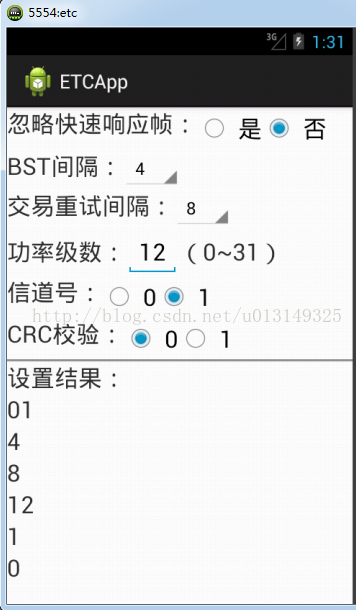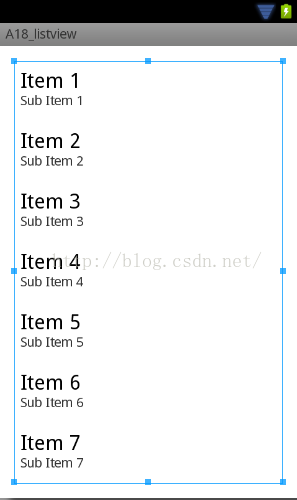編輯:關於Android編程
本文實例講述了Android編程使用HTTP協議與TCP協議實現上傳文件的方法。分享給大家供大家參考,具體如下:
Android上傳文件有兩種方式,第一種是基於Http協議的HttpURLConnection,第二種是基於TCP協議的Socket。 這兩種方式的區別是使用HttpURLConnection上傳時內部有緩存機制,如果上傳較大文件會導致內存溢出。如果用TCP協議Socket方式上傳就會解決這種弊端。
HTTP協議HttpURLConnection
1. 通過URL封裝路徑打開一個HttpURLConnection
2.設置請求方式以及頭字段:Content-Type、Content-Length、Host
3.拼接數據發送
示例:
private static final String BOUNDARY = "---------------------------7db1c523809b2";//數據分割線
public boolean uploadHttpURLConnection(String username, String password, String path) throws Exception {
//找到sdcard上的文件
File file = new File(Environment.getExternalStorageDirectory(), path);
//仿Http協議發送數據方式進行拼接
StringBuilder sb = new StringBuilder();
sb.append("--" + BOUNDARY + "\r\n");
sb.append("Content-Disposition: form-data; name=\"username\"" + "\r\n");
sb.append("\r\n");
sb.append(username + "\r\n");
sb.append("--" + BOUNDARY + "\r\n");
sb.append("Content-Disposition: form-data; name=\"password\"" + "\r\n");
sb.append("\r\n");
sb.append(password + "\r\n");
sb.append("--" + BOUNDARY + "\r\n");
sb.append("Content-Disposition: form-data; name=\"file\"; filename=\"" + path + "\"" + "\r\n");
sb.append("Content-Type: image/pjpeg" + "\r\n");
sb.append("\r\n");
byte[] before = sb.toString().getBytes("UTF-8");
byte[] after = ("\r\n--" + BOUNDARY + "--\r\n").getBytes("UTF-8");
URL url = new URL("http://192.168.1.16:8080/14_Web/servlet/LoginServlet");
HttpURLConnection conn = (HttpURLConnection) url.openConnection();
conn.setRequestMethod("POST");
conn.setRequestProperty("Content-Type", "multipart/form-data; boundary=" + BOUNDARY);
conn.setRequestProperty("Content-Length", String.valueOf(before.length + file.length() + after.length));
conn.setRequestProperty("HOST", "192.168.1.16:8080");
conn.setDoOutput(true);
OutputStream out = conn.getOutputStream();
InputStream in = new FileInputStream(file);
out.write(before);
byte[] buf = new byte[1024];
int len;
while ((len = in.read(buf)) != -1)
out.write(buf, 0, len);
out.write(after);
in.close();
out.close();
return conn.getResponseCode() == 200;
}
TCP協議Socket
1.我們可以使用Socket發送TCP請求,將上傳數據分段發送
示例:
public boolean uploadBySocket(String username, String password, String path) throws Exception {
// 根據path找到SDCard中的文件
File file = new File(Environment.getExternalStorageDirectory(), path);
// 組裝表單字段和文件之前的數據
StringBuilder sb = new StringBuilder();
sb.append("--" + BOUNDARY + "\r\n");
sb.append("Content-Disposition: form-data; name=\"username\"" + "\r\n");
sb.append("\r\n");
sb.append(username + "\r\n");
sb.append("--" + BOUNDARY + "\r\n");
sb.append("Content-Disposition: form-data; name=\"password\"" + "\r\n");
sb.append("\r\n");
sb.append(password + "\r\n");
sb.append("--" + BOUNDARY + "\r\n");
sb.append("Content-Disposition: form-data; name=\"file\"; filename=\"" + path + "\"" + "\r\n");
sb.append("Content-Type: image/pjpeg" + "\r\n");
sb.append("\r\n");
// 文件之前的數據
byte[] before = sb.toString().getBytes("UTF-8");
// 文件之後的數據
byte[] after = ("\r\n--" + BOUNDARY + "--\r\n").getBytes("UTF-8");
URL url = new URL("http://192.168.1.199:8080/14_Web/servlet/LoginServlet");
// 由於HttpURLConnection中會緩存數據, 上傳較大文件時會導致內存溢出, 所以我們使用Socket傳輸
Socket socket = new Socket(url.getHost(), url.getPort());
OutputStream out = socket.getOutputStream();
PrintStream ps = new PrintStream(out, true, "UTF-8");
// 寫出請求頭
ps.println("POST /14_Web/servlet/LoginServlet HTTP/1.1");
ps.println("Content-Type: multipart/form-data; boundary=" + BOUNDARY);
ps.println("Content-Length: " + String.valueOf(before.length + file.length() + after.length));
ps.println("Host: 192.168.1.199:8080");
InputStream in = new FileInputStream(file);
// 寫出數據
out.write(before);
byte[] buf = new byte[1024];
int len;
while ((len = in.read(buf)) != -1)
out.write(buf, 0, len);
out.write(after);
in.close();
out.close();
return true;
}
搭建服務器,完成上傳功能
package cn.test.web.servlet;
import java.io.File;
import java.io.IOException;
import java.util.List;
import javax.servlet.ServletException;
import javax.servlet.http.HttpServlet;
import javax.servlet.http.HttpServletRequest;
import javax.servlet.http.HttpServletResponse;
import org.apache.commons.fileupload.FileItem;
import org.apache.commons.fileupload.FileItemFactory;
import org.apache.commons.fileupload.disk.DiskFileItemFactory;
import org.apache.commons.fileupload.servlet.ServletFileUpload;
public class LoginServlet extends HttpServlet {
private static final long serialVersionUID = 1L;
@Override
public void doGet(HttpServletRequest request, HttpServletResponse response) throws ServletException, IOException {
doPost(request, response);
}
@Override
public void doPost(HttpServletRequest request, HttpServletResponse response) throws ServletException, IOException {
boolean isMultipart = ServletFileUpload.isMultipartContent(request);
if (isMultipart)
try {
FileItemFactory factory = new DiskFileItemFactory();
ServletFileUpload upload = new ServletFileUpload(factory);
List<FileItem> items = upload.parseRequest(request);
File dir = new File(request.getSession().getServletContext().getRealPath("/WEB-INF/upload"));
//創建目錄
dir.mkdir();
for (FileItem item : items)
if (item.isFormField())
System.out.println(item.getFieldName() + ": " + item.getString());
else{
item.write(new File(dir,item.getName().substring(item.getName().lastIndexOf("\\")+1)));
}
} catch (Exception e) {
e.printStackTrace();
}
else {
System.out.println(request.getMethod());
System.out.println(request.getParameter("username"));
System.out.println(request.getParameter("password"));
}
}
}
希望本文所述對大家Android程序設計有所幫助。
 android中RadioGroup、RadioButton、Spinner、EditText用法詳解(含示例截圖和源代碼)
android中RadioGroup、RadioButton、Spinner、EditText用法詳解(含示例截圖和源代碼)
今天在項目中用到了android中常用的RadioGroup、RadioButton、Spinner、EditText等控件,在此介紹一下它們的用法,希望對
 Android打造屬於自己的新聞平台(客戶端+服務器)
Android打造屬於自己的新聞平台(客戶端+服務器)
完全屬於自己的新聞展示平台,展示給大家,希望大家喜歡。一、新聞的數據庫的構建腳本代碼如下:(使用的mysql5.0 數據庫)SET SQL_MODE = NO_AUTO_
 Android實現3D旋轉的View
Android實現3D旋轉的View
今天在網上看到一篇文章寫關於Android實現3D旋轉(http://www.ibm.com/developerworks/cn/opensource/os-cn-and
 Android 自定義Adapter
Android 自定義Adapter
一、VC與模板概念的理解MVC本來是存在於Desktop程序中的,M是指數據模型,V是指用戶界面,C則是控制器。使用MVC的目的是將M和V的實現代碼分離,從而使同一個程序